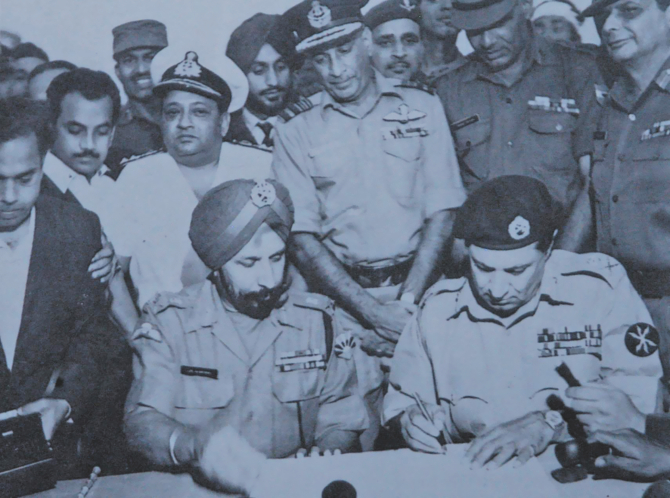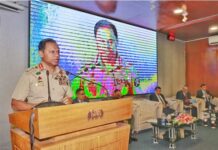“How many Hindus have you killed?”
These chilling words came from no other person than the chief of Pakistan army for its eastern command, General Amir Abdullah Khan Niazi.
“General Niazi visited my unit at Thakurgaon and Bogra,” Lt Col Aziz Ahmed Khan, a Pakistan army officer, in his deposition before an inquiry commission said. “He asked us how many Hindus we had killed. In May, there was an order in writing to kill Hindus. This order was from Brigadier Abdullah Malik of 23 Brigade.”
The Hamoodur Rahman Commission was set up by the Pakistan government on 26 December 1971 soon after the birth of Bangladesh through a bloody war to find out the reasons why the Pakistan army was defeated on the soil of its eastern wing.
Those who then played the key role in the military and civil administration gave their deposition before the commission headed by then chief justice of Pakistan Hamoodur Rahman. They include Lt Gen Niazi, Maj Gen Rao Farman Ali, who was responsible for the operation searchlight on the night of March 25, Maj Gen Mohammad Jamshed, who was GOC of 36 (A) division of East Pakistan, Rear Admiral M Sharif, the flag officer commanding the Pakistan Navy in East Pakistan, Muzaffar Hussain, who was the chief secretary, and Mahmood Ali Chaudhury, who was IGP.

The picture emerging from their statements is horrifying. It showed how a loony, trigger-happy army driven by lust for women and wine, greed for wealth, devoid of all morality and holding a deep hatred against the Bangalees swung into a mass scale killing, rape and looting.
From the night of 25th March, 1971, they embarked on the killing mission ‘in the name of God and a united Pakistan’, as Simon Dring, a British journalist who was in Dhaka at that time to witness the first wave of the genocide, reported in the London-based newspaper The Telegraph. He had to fly to Bangkok after he was caught by the Pakistan army while covering the atrocities unleashed on the Bangalees.
To these devilish army officers, Bangalees were no more than just some clay pigeons to be shot down as mentioned by one Brigadier Iqbalur Rehman Shariff. In his deposition, the brigadier said during his visit to formations in East Pakistan General Gul Hassan used to ask the soldiers — “How many Bengalis have you shot?”
But this genocide did not happen on impulse or was not an accidental outcome of the war that Pakistan had imposed on the Bangalees. It was a long-drawn plan hatched in the western wing. The landslide victory of the Awami League in the 1970 election (League bagged 160 seats out of 162 in East Pakistan) made it clear that Sheikh Mujibur Rahman was destined to be the prime minister of Pakistan, a prospect despised by the ‘high-browed, pure bearer of Islam’ West Pakistanis.
‘THE GREEN LAND OF EAST PAKISTAN WILL BE PAINTED RED’
The West Pakistan military and political leadership planned the genocide much before March 25, 1971. Major Gen Rao Farman Ali wrote in his table diary “The green land of East Pakistan will be painted red” as Gen Niazi mentioned in his book The Betrayal of East Pakistan. Niazi explained that “it was painted red by Bengali blood”.
As a ploy not to hand over power to the Awami League and to get militarily ready, then president Gen Yahiya Khan staged a dialogue game between Mujib and Zulfikar Ali Bhutto, the leader of the defeated Pakistan People’s Party (PPP), from March 15 to March 25.
Taking this time gap, the Pakistan government was flying in soldiers and ammunitions from the Western wing.
As all preparation for the army crackdown was complete, Yahiya postponed the dialogue and left Dhaka on the March 25 night, ordering General Tikka Khan, then head of the eastern command, to “sort them out” (The Betrayal of East Pakistan, Niazi).
From midnight onward, one of the worst genocides in history began as tanks rumbled down the Dhaka streets firing salvos.
While describing the use of excessive force on that night, one Brigadier Shah Abdul Qasim told the commission that “no pitched battle was fought on the 25th of March in Dacca. Excessive force was used on that night. Army personnel acted under the influence of revenge and anger during the military operation.”
The Hamoodur Rahman Commission maintained that mortars were used to blast two residential halls, thus causing excessive casualties.
The horror of the night comes alive in the butcher Niazi’s own book: “Peaceful night was turned into a time of wailing, crying and burning. General Tikka let loose everything at his disposal as if raiding an enemy, not dealing with his own misguided and misled people. The military action was a display of stark cruelty, more merciless than the massacres at Bukhara and Baghdad by Chengis Khan and Halaku Khan or at Jallianwalabag by the British general Dyer.”
As the Pakistan army’s guns roared and innocent Bangalees were machine-gunned, the generals sat happily on the lawn of the Second Capital (where the MP hostels are today) and watched Dhaka burn in flames.
Major Siddiq Salik who was then the public relations officer of the eastern command wrote in his book Witness to Surrender: “Tikka Khan and his staff were to spend the night at the Martial Law Headquarters in the Second Capital to watch the progress of action in and outside Dacca.
“Junior officers like me started collecting at Headquarters at about 10:00pm. They laid out sofas and easy chairs on the lawn and made arrangements for tea and coffee to last the night. The city wrapped in starlight, was deep in slumber. The setting was perfect for anything but a bloody holocaust.”
The same ruthlessness was let loose all over the country for nine long months.
The statements appearing in the evidence of Lt. Col. Aziz Ahmed Khan who was Commanding Officer 8 Baluch and then CO 86 Mujahid Battalion are also directly relevant. He said, “Brigadier Arbbab also told me to destroy all houses in Joydebpur. To a great extent I executed this order.”
The commission observed that “indiscriminate killing and looting could only serve the cause of the enemies of Pakistan. In the harshness, we lost the support of the silent majority of the people of East Pakistan…. The Comilla Cantonment massacre (on 27th/28th of March, 1971) under the orders of CO 53 Field Regiment, Lt. Gen. Yakub Malik, in which 17 Bengali Officers and 915 men were just slain by a flick of one Officer’s fingers should suffice as an example.”
Looting also became the order of the day for the morally bankrupt Pakistan army.
Lt. Gen Niazi, as Maj Gen Farman Ali told the commission, on the very first day when he took over command from Gen Tikka Khan said: “What have I been hearing about shortage of rations? Are not there any cows and goats in this country? This is enemy territory. Get what you want. This is what we used to do in Burma.”
Niazi took over command of the eastern zone on April 10 after Tikka had already started the genocide.
Another significant statement came from Brigadier Mian Taskeenuddin. He said: “Many junior and other officers took the law into their own hands to deal with the so-called miscreants. There have been cases of interrogation of miscreants which were far more severe in character than normal and in some cases blatantly in front of the public. The discipline of the Pakistani army as was generally understood had broken down. In a command area (DhoomGhat) between September and October miscreants were killed by firing squads.”
Niazi, apparently in an endeavour to put the blame on his predecessor (then) Lt Gen Tikka Khan, stated before the commission that “military action was based on use of force primarily, and at many places indiscriminate use of force was resorted to which alienated the public against the Army. Damage done during those early days of the military action could never be repaired, and earned for the military leaders names such as ‘Changez Khan’ and ‘Butcher of East Pakistan.”
But Niazi was held in disdain by his own soldiers. He was corrupt and an infamous womaniser. Officials knew he was involved in the smuggling of pan (beetle leaf) in which his son also had a stake.
A witness told the commission: “The troops used to say that when the Commander (Lt Gen Niazi) was himself a raper (sic), how could they be stopped?”
Maj Gen Rao Farman Ali said: “Harrowing tales of rape, loot, arson, harassment, and of insulting and degrading behaviour were narrated in general terms.”
The Hamoodur Rahman Commission came to the conclusion that the words and personal actions of Lt Gen Niazi were calculated to encourage the killings and rape. It felt the necessity for the Government of Pakistan to take effective action to punish those who were responsible for the atrocities.
Names of 195 officers came up for the atrocities. However, nothing was done against them.
When the war came to a close after the deaths of three million Bangalees and the rape of 200,000 women, General Niazi who had encouraged and overseen all these atrocities and gained the title of Tiger Niazi broke down in tears and sobbed at the Governor House.
He cried not for all the crimes that he had committed against humanity but for his own undignified end to his career as a soldier.
Source: The Daily Star









